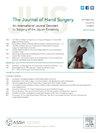A Kinematic Analysis of Wrist and Carpal Function Using Four-Dimensional Computed Tomography Technology: A Dynamic Perspective
IF 2.1
2区 医学
Q2 ORTHOPEDICS
引用次数: 0
Abstract
Purpose
An emerging imaging modality, four-dimensional computed tomography, can provide dynamic evaluation of carpal motion, which allows for a better understanding of how the carpals work together to achieve range of motion. The objective of this work was to examine kinematic motion of the carpus through a flexion/extension arc of motion using four-dimensional computed tomography.
Methods
A convenience sample of 20 uninjured participants underwent a four-dimensional computed tomography scanning protocol through a complete arc of flexion/extension motion. Kinematic changes in motion were quantified using helical axes motion data for each carpal. Rotation angles were compared between bones to identify differences in kinematic motion between bones.
Results
The bones within the proximal carpal row, the lunate, scaphoid, and triquetrum, rotate significantly to differing magnitudes at the ends of motion (40° of flexion and 40° of extension). The scaphoid rotates to the highest magnitude, followed by the triquetrum, and lastly, the lunate. The distal carpal row bones rotate to similar magnitudes throughout the entire range of motion.
Conclusions
This work describes the kinematics of the carpals throughout dynamic in vivo flexion and extension.
Clinical relevance
This study adds to an understanding of wrist mechanics and the possible clinical implications of pathological deviation from baseline kinematics.
动态视角下的四维计算机断层扫描技术对腕关节功能的运动学分析。
目的:一种新兴的成像方式,四维计算机断层扫描,可以提供腕骨运动的动态评估,从而更好地了解腕骨如何协同工作以实现运动范围。这项工作的目的是通过使用四维计算机断层扫描检查腕骨的屈伸运动弧的运动学运动。方法:20名未受伤的参与者通过完整的屈伸运动弧线进行了四维计算机断层扫描。使用每个腕关节的螺旋轴运动数据量化运动的运动学变化。通过比较骨骼之间的旋转角度来识别骨骼之间运动的差异。结果:腕骨近端、月骨、舟状骨和三骨骨在运动结束时(屈曲40°和伸展40°)旋转显著。舟状骨的旋转幅度最大,其次是三角骨,最后是月骨。腕远端排骨在整个活动范围内旋转到相似的幅度。结论:这项工作描述了腕骨在体内动态屈伸的运动学。临床相关性:本研究增加了对腕部力学的理解和病理偏离基线运动学可能的临床意义。
本文章由计算机程序翻译,如有差异,请以英文原文为准。
求助全文
约1分钟内获得全文
求助全文
来源期刊
CiteScore
3.20
自引率
10.50%
发文量
402
审稿时长
12 weeks
期刊介绍:
The Journal of Hand Surgery publishes original, peer-reviewed articles related to the pathophysiology, diagnosis, and treatment of diseases and conditions of the upper extremity; these include both clinical and basic science studies, along with case reports. Special features include Review Articles (including Current Concepts and The Hand Surgery Landscape), Reviews of Books and Media, and Letters to the Editor.

 求助内容:
求助内容: 应助结果提醒方式:
应助结果提醒方式:


